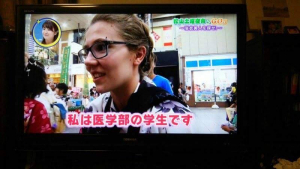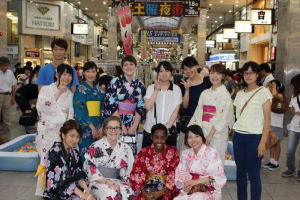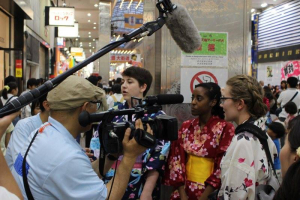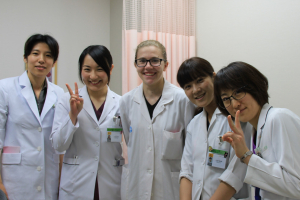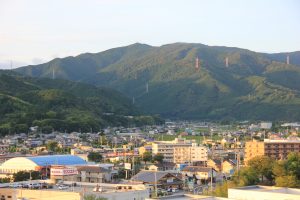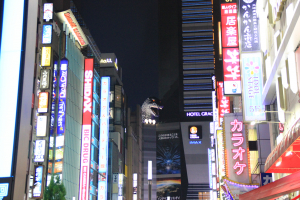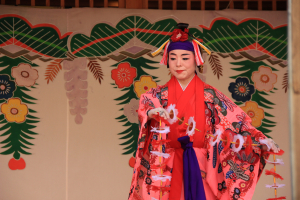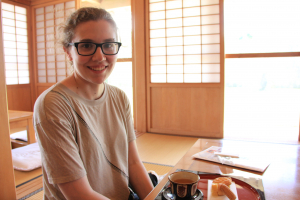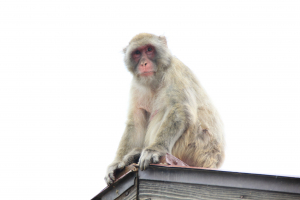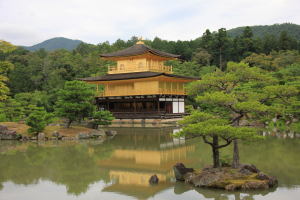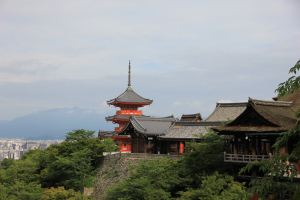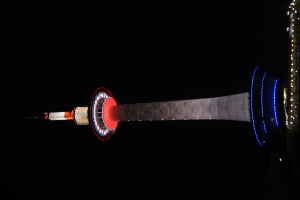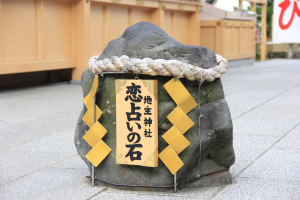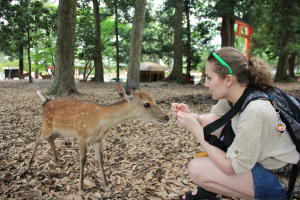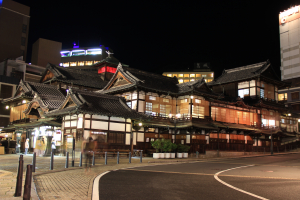Going on a month-long medical exchange to Japan was a way for me to rediscover the country I had fallen in love with six years prior. In high-school, I made the fateful decision to go on a student exchange in Japan for one year. Full of enthusiasm but equipped with only rudimentary knowledge about the country I had started my 30-hour journey to the land I would soon come to think of as my second home. It felt a bit like being brought into infancy a second time, arriving in a new family in an unfamiliar environment, being unable to speak the language and not knowing the rules and social norms to which people adhered. It was a long year of constant learning but when I left Japan it was with a heavy heart and a promise of returning one day. So it was with great excitement that I applied to do a month-long medical apprenticeship at a Japanese university hospital, hoping to renew my connection to the country I had come to love. At the same time I was excited to be able to witness the possible differences and similarities in medical care in these two countries so far removed from each other. I was accepted to do my exchange at Ehime University near Matsuyama city (a place, I must admit, I had to look up on a map before my departure). Upon arrival in Ehime (after a long and gruelling journey consisting of 16 hours of flying, three stops and 10 hours of waiting, a lost luggage and a sudden onset of cold) I was welcomed by the Ehime charter of the International Federation of Medical Students Associations in the torrential rain and taken to my dorm. Adhering to a lifelong tradition of not preparing terribly well for things, I had no raingear and no umbrella, but told myself that since the dorm was very close to the hospital I could not get so terribly wet on the walk (or mad dash) between the two. And so it was that I dashed to the hospital the next day to meet my contact person, my attending physician and the doctors of the Department of Breast Surgery and Department of hepato-biliary-pancreatic department, where I would come to spend the next four weeks.
The first week I spent getting to know the hospital and the staff. The largest portion of my time was spent shadowing the doctors of the breast surgery department, observing the diagnosis, treatment and follow-up care of patients diagnosed with breast cancer. I also got the chance to observe surgeries, not only of the breast, but also of the liver, gallbladder, pancreas, colon, uterus and many more as my mentor wanted me to experience all that the hospital had to offer. The protocols were similar to the ones followed in Iceland but the hospital had some exciting technology, such as three-dimensional endoscopy and the use of live surgical videos in teaching. However, what I found most interesting was that on the morning after operations, the surgeons would have a short presentations on their surgeries illustrated with hand-drawn pictures. It was a great way to deepen the students’ understanding of the procedures.
Outside of work I managed to make some good friends both among the doctors and surgeons of the department as well as with my fellow students. After hours I would meet up with other medical students and get to know the town. I was excited to learn that as it was the rainy season everywhere would soon be crawling with frogs and I would excitedly ride my bike at night to their croaking in the rice fields to find them hopping along on the pavements. The rainy season did however come with the downside of sometimes arriving to school soaked through to the bone on my two minute walk to school, but all in all I had a great time.
Staying in a small town on the outskirts of a “tiny” city (by Japanese standards) of only 500,000 people, I had worried that I would not be able to find much to pass the time. But getting to know the town was even more exciting than I had dared hope, and between weekend festivals in the city, the wonders of the encircling mountain forests with their hidden temples and Japans oldest hot spring, Dōgo Onsen, I completely fell for this city I had shortly before not even known existed.
Thanks to the grant awarded to me by the Watanabe foundation I was able to strengthen the ties to the country I had come to love, deepen my knowledge of the language and culture, learn about the differences and similarities of medical care in both countries as well as create lasting friendships with some of the most wonderful and caring people I have ever met, and for that I am deeply grateful.
Marta Ólafsdóttir
Icelandic
Mánaðarlangt skiptinám til Japan sumarið 2016 var mér tækifæri til að kynnast á ný landi sem ég hafði fallið fyrir sex árum áður. Í menntaskóla tók ég þá afdrifaríku ákvörðun að fara í skiptinám til Japan í eitt ár. Full ákafa, þrátt fyrir mjög takmarkaða vitneskju um landið, hafði ég lagt af stað í 30 klukkustunda ferðalag til staðarins sem yrði mér brátt mitt annað heimili. Það var nokkurs konar endurfæðing að koma inn í nýja fjölskyldu í nýju umhverfi, vera mállaus og þekkja ekki félagslegu gildin sem fólk fylgdi. Fyrir höndum var langt ár af stöðugri endurmenntun, en þegar ég fór heim frá Japan var það með tregafullu hjarta og ósk um að koma einhvern tímann aftur.
Ég var því full tilhlökkunar er ég sótti um að fara í mánaðarlanga starfsþjálfuná japönsku háskólasjúkrahúsi og vonaði að ég gæti þannig endurnýjað tengslin við landið sem er mér svo kært. Einnig fannst mér spennandi að bera saman læknisþjónustu þessara tveggja landa. Mér var boðið að koma til Ehime háskóla rétt hjá Matsuyama-borg (á svæði sem ég verð að viðurkenna að ég gat ekki fundið á korti fyrir brottför) og eftir 16 klukkustunda flug, 3 stopp, 10 tíma bið, týnda ferðatösku og skyndilegt kvef tók Alþjóðadeild læknanema í Ehime á móti mér í hellidembu og keyrði mig í nemendaíbúðina þar sem ég dvaldi næstu fjórar vikur. Það hefur verið ævilöng hefð hjá mér að undirbúa mig aldrei sérstaklega vel fyrir neitt, og þar sem ég vildi ekki bregða út af vananum nú hafði ég hvorki tekið með mér regnhlíf né regnföt þegar ég lagði af stað til þessarar litlu hitabeltiseyju á regntímabilinu. Ég mætti því rennblaut en full ákafa á spítalann fyrsta daginn minn. Þar kynntist ég læknunum á brjóstaskurðadeild og lifrar-, gall- og brisskurðdeild, sem leiðbeindu mér meðan á dvöl minni stóð.
Fyrstu vikuna nýtti ég til að kynnast spítalanum og starfsfólki hans. Ég var mest á deild brjóstaskurðlækninga og fylgdist þar með greiningu, aðhlynningu og eftirfylgd sjúklinga sem greindust með brjóstakrabbamein. Einnig fékk ég fékk að fylgjast með skurðaðgerðum, bæði á brjóstaskurðdeild en einnig á öðrum deildum, fyrst og fremst lifrar-, gall- og brisskurðdeild. Verklagið var svipað því sem gerist á Íslandi en spítalinn hafði ýmsar tækninýjugar sem áhugavert var að sjá, m.a. aðgerðir framkvæmdar með þrívíddarholsjá og upptökur aðgerða notaðar til kennslu. Það sem mér þótti einna skemmtilegast var þó sú hefð að daginn eftir aðgerð hélt hver skurðlæknir erindi um skurðaðgerðirnar sem hann hafði framkvæmt og myndskreytti með handteiknuðum myndum. Það var ómetanleg viðbót til að dýpka skilning nemendanna og samstarfsfólksins á því sem farið hafði fram.
Utan vinnunnar náði ég að eignast marga góða vini meðal starfsfólksins og ekki síður læknanemanna sem voru á deildinni með mér. Á kvöldin reyndi ég að kynnast bænum betur og hitta hina nemana þegar þeir áttu lausa stund. Ég var mjög glöð að uppgötva að á regntímabilinu var bærinn uppfullur af froskum og átti ég það til að hjóla út að hrísgrjónaökrunum til að heyra þá kvaka. Þrátt fyrir að regntímabilinu fylgdi sá meingalli að ég mætti oftar en ekki gegnblaut í skólann þá naut ég dvalarinnar mjög.
Ég dvaldi í litlum bæ í útjaðri „smá“borgarinnar Matsuyama (sem þykir nokkuð lítil í Japan þrátt fyrir að íbúar séu 500.000) og hafði óttast að ekki væri margt í boði til að stytta mér stundir. En bærinn var meira spennandi en ég hafði leyft mér að vona og ég féll fljótt fyrir Matsuyama og hennar helgarhátíðum, köstulum og ekki síst Dōgo Onsen, elstu heitavatnslaug Japans þar sem fólk hefur baðað sig í þúsundir ára.
Þökk sé styrknum frá Watanabe sjóðnum náði ég að styrkja tengslin við Japan á ný, auka þekkingu mína á tungumálinu og menningunni, kynnast læknisþjónustu í nýju landi og síðast en ekki síst kynnast yndislegu og hugulsömu fólki sem ég er stolt að fá að kalla vini mína í dag. Ég er Watanabesjóðnum mjög þakklát fyrir að gefa mér þetta ógleymanlega tækifæri.
Marta Ólafsdóttir

